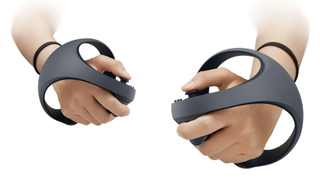How one PSVR 2 feature could change your VR experience on PS5 forever
Foveated rendering could harness the full power of the PS5 for PSVR 2 in intelligent ways.

We know PSVR 2 is on the way – Sony’s second generation PlayStation VR headset has already been confirmed by the company as an in-development accessory for its latest-and-greatest console, the PS5. But, orb-like controllers aside, Sony has kept schtum on what its new head-mounted unit will be capable of.
However, recent rumors, if true, give a good indication of what we may expect from the PSVR 2. The headline specs will rightly see VR fans getting excited about a large resolution jump, 4000 × 2040 pixels (2000 × 2040 per eye), which would be a huge leap over the 1080p / 960 x 1080 output of the original PlayStation VR. There’s also talk of inside out tracking, removing the need for a separate camera unit, rumble within the headset and a single USB-C cable connection that would make set-up far simpler.
But the rumors also point to another feature being in the mix for PSVR 2, one that may pass by all but the most avid VR user. And that’s foveated rendering, a technique that can potentially push visual performance to all new heights – while also being kind to CPU and GPU performance.
- Best PlayStation VR games
- PSVR 2: what devs want from the future of console VR
- First PSVR 2 game revealed – and it's a doozy
Foveated rendering explained
Foveated rendering is a process for displaying visuals on a VR (or augmented reality) display that more closely mirrors how our eyes work in the real world.
Think of the screen you are focusing on now. See how your eyes are zeroing in on the words in front of you? The rest of your peripheral vision has taken a back seat, right? Your brain focuses its attention (and thus clarity) onto the object you're paying attention to. And while those things at the edge of your vision don’t disappear, they’re slightly less clear until you decide to focus on them.

That’s exactly how foveated rendering works. Whether using an eye-tracking process or gaze-tracking based upon where your head is pointed, foveated rendering intelligently ups the detail on the part of a digital VR scene you are paying attention to, while dynamically dropping the resolution of the world around your focus point.
As such, only the point on a VR image that you’re focused on is displayed in detail, meaning that the CPU and GPU cost for the rest of the image is reduced. But you don’t notice it, as the area that you care about is always being rendered at the highest possible resolution. In the case of wireless headsets it’s a great way to extend battery life as well as make the best possible use of resources, and in the case of a wired headset allows all the extra resources to be funnelled to making the most important part of an image stunning.
Get daily insight, inspiration and deals in your inbox
Sign up for breaking news, reviews, opinion, top tech deals, and more.
What headsets currently use foveated rendering?
If the PSVR 2 does use foveated rendering, it’ll be far from the first headset to put it into use. Fove, a fully-funded Kickstarter project, was the first headset to be built around the concept, built by a Japanese company of the same name. It pairs the foveated rendering with eye-tracking features, and is similar in principle to the Finnish Varjo headset, as excellently summarised in this Virtual Reality Oasis YouTube clip:
As far as more familiar VR names go, HTC experimented with the concept in its Vive Pro Eye headset – but has seemingly dropped chasing it with the release of its latest devices, the HTC Vive Pro 2 and HTC Vive Focus 3.
Foveated rendering can be achieved without eye-tracking (Oculus allows for fixed-focus foveated rendering at a software level, based on a user’s directional gaze, rather than eye movements). But the technique feels most natural and useful when combined with eye-tracking hardware support.
Why is foveated rendering important for the PSVR 2?
So, to be clear, we’re currently working on rumored specs for the PSVR 2 here, rather than officially-stated ones from Sony. But what we do know is the specs of the PlayStation 5 that will be powering the PSVR 2.
And that’s where the foveated rendering potentially becomes very important. For the sake of living room play, as was the case with the PSVR, the PSVR 2 will be almost certainly hooked up to a PS5 console that’s outputting to both a TV, and the headset itself, simultaneously.

As a next-gen console, we can assume that most players will be playing with their PS5 hooked up to a 4K TV, which would suggest the console would be pushing pixels out to not just a 3840 x 2160 pixel display, but also the 4000 × 2040 pixel headset. That’s a lot of pixels, and unless Sony is prepared to undermine the console's 4K selling point, it’s got to maintain those resolutions across both displays – or eliminate any hope of local social play by killing TV output while the PSVR 2 is in use, preventing the passive enjoyment of watching someone else’s VR viewpoint.
Foveated rendering could claw back some much-needed resources from the rendered world for the GPU and CPU to play with. Keep in mind that even high-end gaming PCs and GPUs, when playing with high-end virtual reality systems, have to carefully manage their resources at high resolutions and, for all its power, even the PS5 can’t match the highest-end gaming PCs.
If PSVR 2 can make successful use of foveated rendering then, it’ll let Sony’s developers continue to give the illusion that their entire gaming worlds are as detailed as the real one – even if it’s actually softening the edges of your peripheral vision. It should up the immersion in forthcoming VR games, and help the PS5 maintain its position as the home of visually-impressive adventures.
- Where to buy PS5: all the latest restock updates
Gerald is Editor-in-Chief of iMore.com. Previously he was the Executive Editor for TechRadar, taking care of the site's home cinema, gaming, smart home, entertainment and audio output. He loves gaming, but don't expect him to play with you unless your console is hooked up to a 4K HDR screen and a 7.1 surround system. Before TechRadar, Gerald was Editor of Gizmodo UK. He is also the author of 'Get Technology: Upgrade Your Future', published by Aurum Press.
